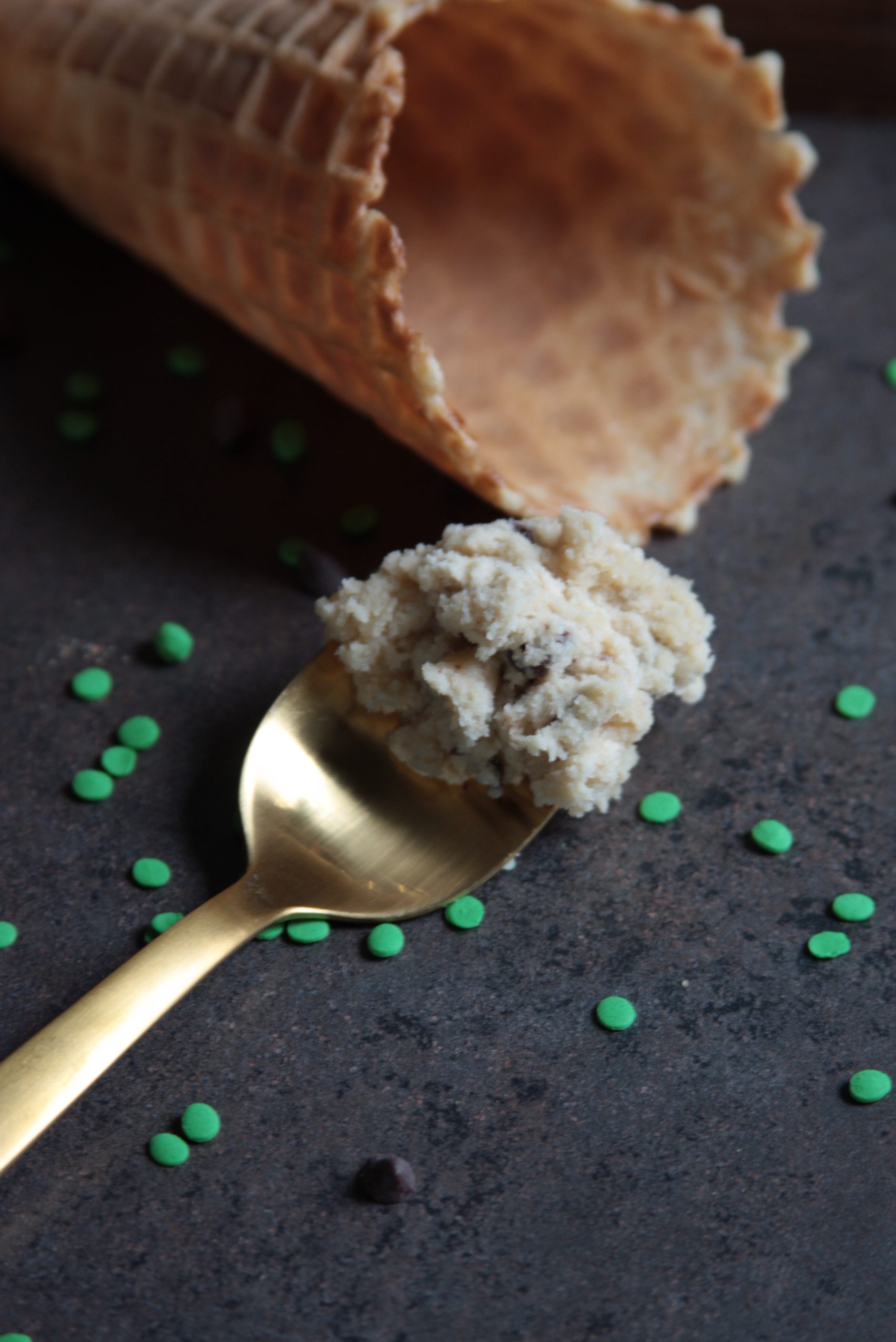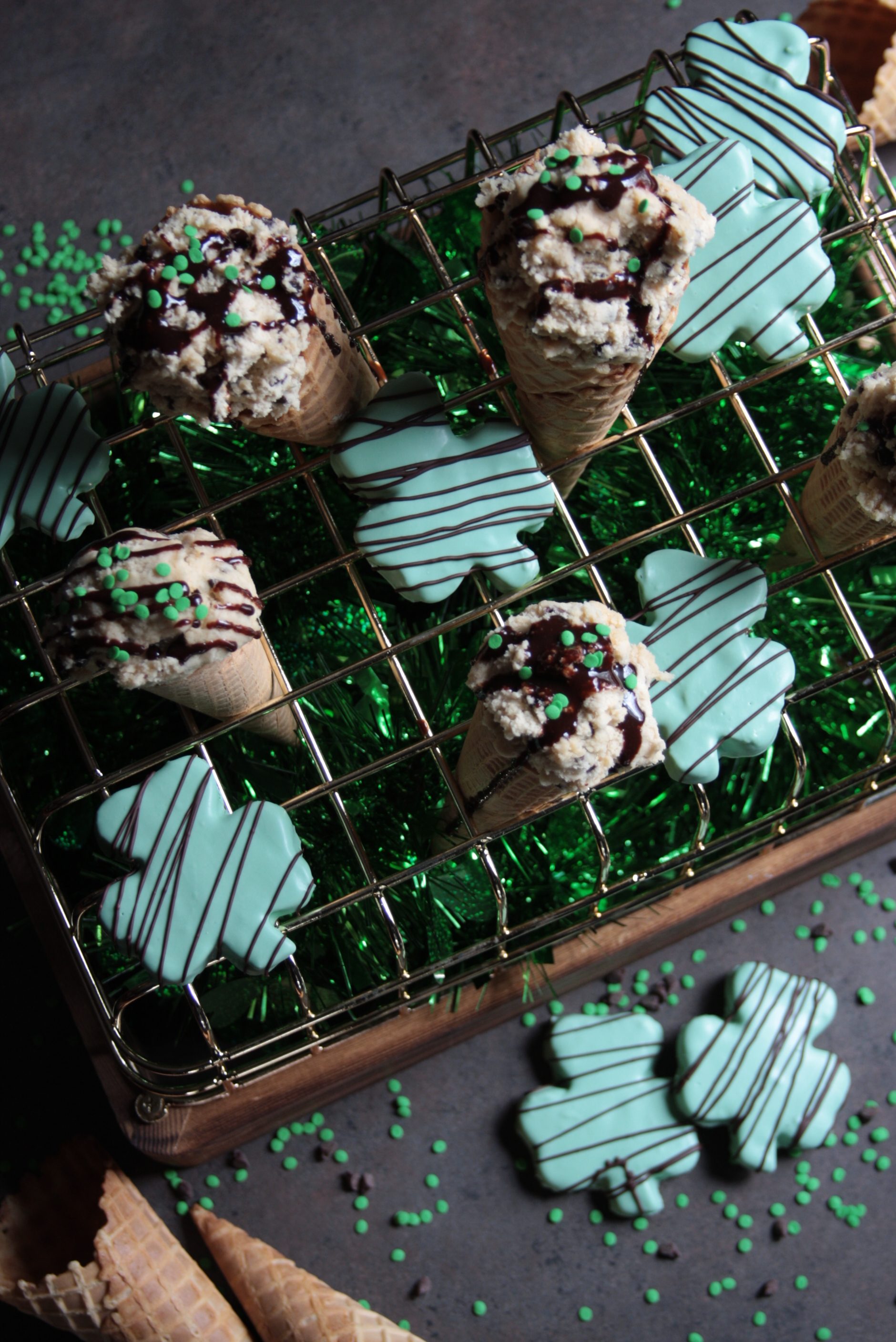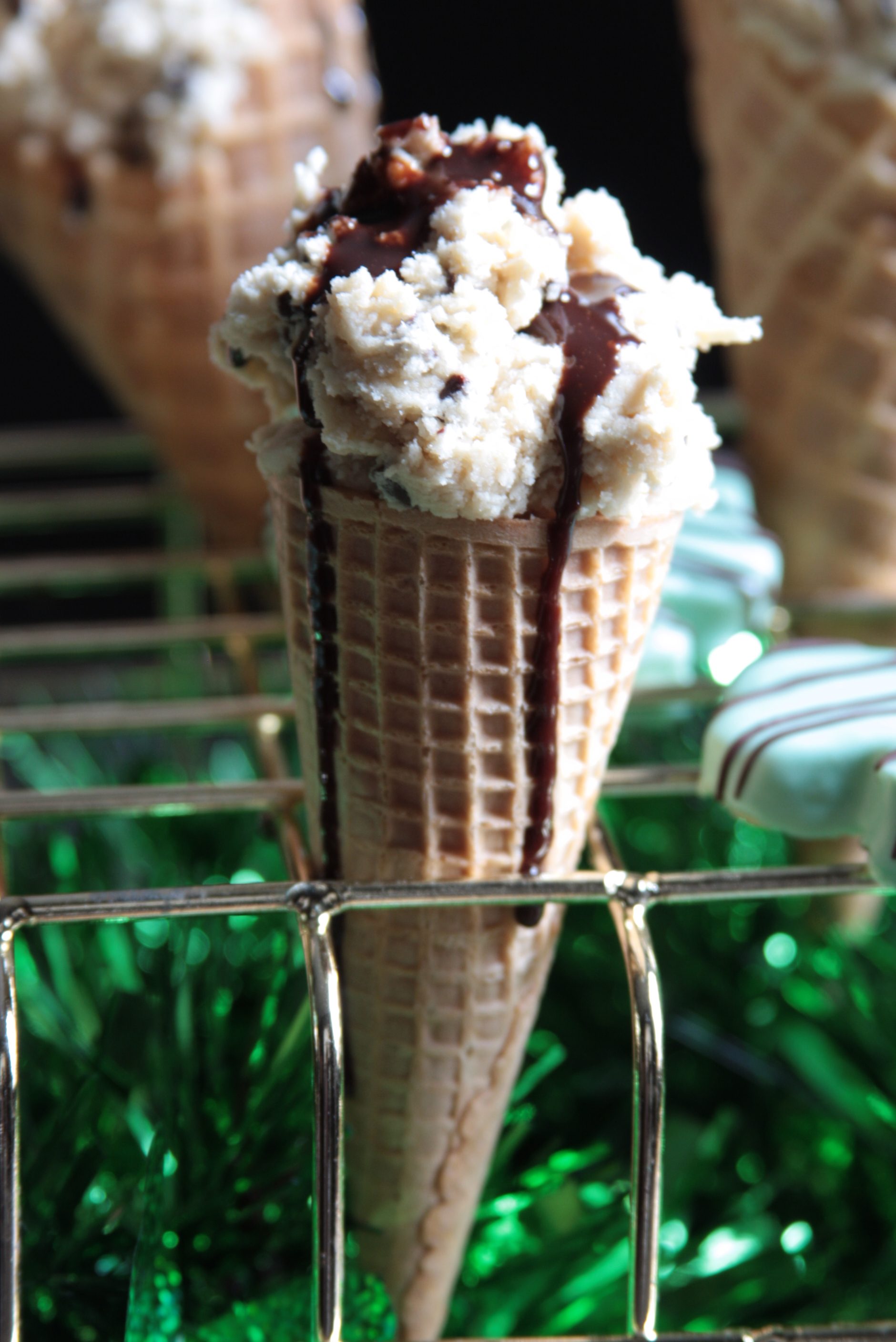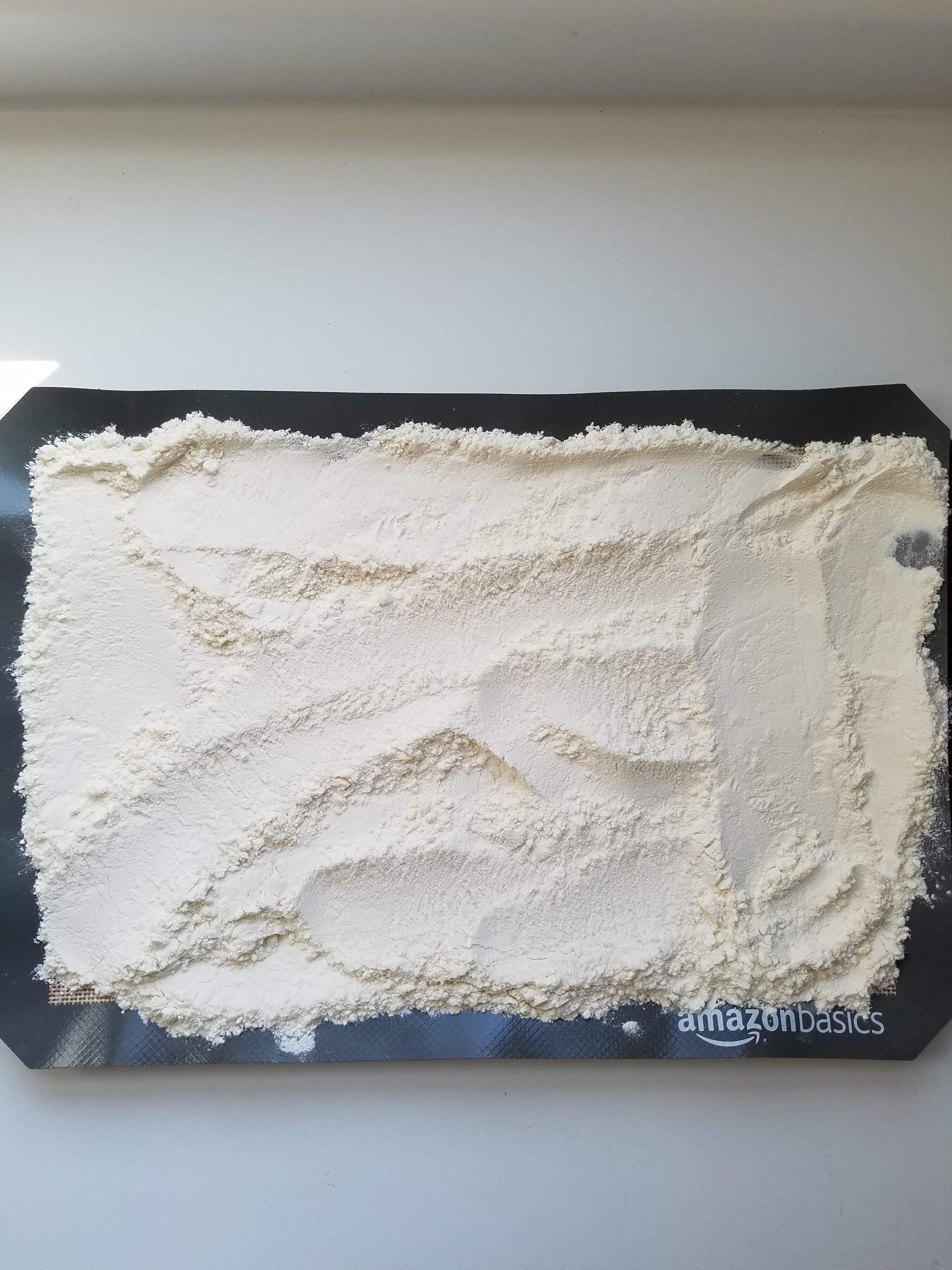
Ah, cookie dough. The forbidden treat. Well, it’s supposed to be forbidden anyway. That hasn’t stopped me from eating it EVERY SINGLE TIME I’ve made cookies though. It hasn’t killed me yet, but I’m risking a whole slew of sicknesses, most notably e coli and salmonella, by eating it.
I may have never thought much more about it until my great friend Kaci told me about this awesome new shop in New York called Cookie DŌ NYC. It basically looks like an ice cream shop but instead of the ice cream, it’s cookie dough, served in cones, cups, ice cream sandwiches or milkshakes, and filled and topped with everything you could fill and top ice cream with. BRILLIANT!

Then I read an article about this shop and they talked about how the cookie dough was safe to eat because they used a pasteurized egg product and tempered flour to avoid risk of bacteria. Wait…what? I knew the eggs were a risk but the flour? When did this start? Not that it would have stopped me from eating it anyway 😛 but I’m so out of the loop. So I did some research.
Safety Issues
The FDA flat out says don’t eat raw dough. They explain their stance by describing how not only eggs, but also raw flour can harbor bacteria because the grain comes directly from fields that are normally not treated to kill bacteria. Wild animals, of course, have access to those fields so it’s possible they could pass harmful bacteria to the grain and this is how flour has become tainted with e coli in the past.

Other than the FDA, the most recent articles I found are from July of 2016 talking about the e coli outbreak that started in December of 2015 with General Mills flour as well as a June 2009 outbreak of e coli in Nestle Toll House cookie dough. From what I can find, these are the only two outbreaks of e coli related to flour to date and for the 2009 outbreak, it didn’t sound like they were completely sure it was the flour that was to blame. I also can’t find any reports of anyone who has died from e coli tainted flour and while the numbers vary from site to site, it looks like fewer than 130 people total have ever become sick from e coli tainted flour. It seems that most of the time, e coli outbreaks come from produce.
Armed with all of this information, I wanted to create a cookie dough recipe that not only tasted great, but was as safe to eat as I could possibly make it. I tried finding out where to buy pasteurized eggs and tempered flour. No luck. I’m sure if I kept looking I could find it, but in my opinion, if it can’t be bought on Amazon or in the grocery store, it’s too much work.

There are plenty of cookie dough recipes that don’t contain eggs so that would solve the egg problem but what about the flour? I found a few blog posts about microwaving the flour and using a candy thermometer to check the temperature to ensure it gets to the recommended 160 degrees, hot enough to kill any harmful bacteria, but that seemed like a lot of work too and I wasn’t sure how accurate it would be. The second you take it out of the microwave, it starts to cool. Plus, as we all know, microwaves are notorious for having hot spots so what if parts of the flour got to the correct temperature, but others didn’t? If I was going to follow through with this completely safe cookie dough mission, I wanted to be confident in the results.
The Solution to Safety Issues
So what do we know? The FDA says not to eat raw eggs and raw flour. We got rid of the eggs altogether, now we’re just left with the flour. We know baked cookies are completely safe to eat. Generally cooked at about 350 for anywhere from 8-15 minutes.

Then I had one of those “duh” moments. Why don’t I just bake the flour by itself at 350 degrees for 15 minutes? If you can bake it in the cookie that way and it’s safe to eat, then why wouldn’t it be safe baking it that way on it’s own? The oven heats much more evenly than a microwave, you’re going to twice the necessary temperature level for safety, and all it requires is preheating your oven, spreading the flour on a cookie sheet and setting a timer for 15 minutes. Exactly what you’d be doing if you were actually baking the cookies except you only have to do it once instead of several batches worth. Sounds like a plan to me!

But would it make the dough taste any different? From what I can tell, no. It still tastes like the same, sweet, delicious, doughy treat it always has. The flour sort of cakes up and starts to form cracks because it’s being dried out, but it breaks up into its normally powdery state when you stir it up a bit. Problem solved!
PLEASE NOTE: I am not a medical professional or affiliated with the health department in any way. (Though this guy is and he eats raw cookie dough too 😉 ) You should do your own research and make your own decision about whether it’s worth the risk to eat any sort of raw cookie dough. I’m comfortable eating this recipe (or any cookie dough recipe) but that doesn’t mean you should be. Please inform yourself and make your own decision about what is best for you and your family.

Taste Issues and Solutions
Now that the safety problem was solved, what about the taste? I tried several recipes and was surprised at how wildly different they could be. Some were much more dense and smooth like what you’d find in the cookie dough tubes at the grocery store. Others were more light and fluffy from the creamed butter and had sort of a grainy texture from the sugar. Reviews amongst friends were split, so I created a recipe that was exactly what I wanted it to taste like, but I have an easy variation in the notes for those that prefer something closer to the store bought dough.
First, I wasn’t thrilled with the sugary crunch. My husband loved it because he said that’s what homemade cookie dough should be like, but I at least wanted less of it. I found using more brown sugar than granulated helped, then using ultrafine sugar instead of regular granulated made it perfect. You can definitely use granulated, I just prefer it with less of a sugary crunch.
Then there was the texture. Melting the butter gives you the more dense, smooth texture of store bought cookie dough. A lot of the sugar dissolves so you have less of the crunch to begin with, and you’re not whipping the butter so you get a darker, denser dough. You can use the recipe below but melt the butter and mix the sugars in, instead of creaming the sugars and butter together, to get the store bought texture.
Lastly, there was the chocolate. Especially after refrigerating, (and I feel this way about ice cream too), I really don’t like having the soft dough, and then occasionally biting into a rock hard pebble of chocolate. Mini chips were the perfect solution. You still get those chocolaty morsels in there, but they’re small enough that they come to temperature more quickly and you don’t feel like you’re going to break a tooth on one while you’re eating.
And thus, the perfect cookie dough recipe was born!
| Prep Time | 15 minutes |
| Cook Time | 15 minutes |
| Servings |
|
- 55 grams Ultrafine Baker's Sugar* 1/4 cup. You could also use caster sugar or granulated sugar.
- 200 grams brown sugar 1 1/4 cup lightly packed
- 1 cup butter salted, 227 grams
- 1/4 cup whole milk 59 ml
- 260 grams All purpose flour
- 1/2 teaspoon salt I used pink Himalayan but any fine salt will work.
- 1 tablespoon vanilla extract
- 90 grams mini semi-sweet chocolate chips 1/2 cup
Ingredients
|
|
- Preheat oven to 350 degrees.
- Spread flour evenly in a thin layer on a baking sheet. Bake for 15 minutes in preheated oven. Remove from oven and let cool completely before adding to your dough.
- Add butter and sugars to the bowl of a stand mixer. Mix on a high speed for 2-3 minutes or until it become fluffy and lighter in color. Be sure all chunks of the sugars are completely broken up and scrape bowl as needed.*
- Add milk to bowl and mix until fully incorporated.
- Add flour and salt. Again, mix until fully incorporated.
- Add vanilla and mix on a high speed for 2-3 minutes to get the dough as light and fluffy as possible.
- Add your mini chips and mix. It's probably not great for your mixer to mix them in using it so you should probably mix by hand but I despise mixing cookie dough by hand so I always use the mixer. Mix them in using the mixer at your own risk. 😛
- Serve at room temperature or after refrigerating. You can serve it pretty much exactly as you would serve ice cream; in a bowl, in a cone, on a spoon, topped with chocolate syrup and sprinkles or even cut into little shapes or rolled into balls.* I love how soft and fluffy it is at room temp but I wouldn't really be comfortable storing it that way since it does have a bit of milk in it. Best to try to eat it all in one sitting so you don't have to worry about refrigerating it. ;P
*This is the Ultrafine Baker's Sugar I used. You can generally find it in the baking aisle of most grocery stores. Definitely don't buy it online. It's much less expensive in the store but this will give you an idea of what you're looking for.
*If you prefer the denser texture of store bought cookie dough, instead of creaming the butter and sugars, melt the butter and mix in the sugars. Prepare everything else as directed but don't beat for 2-3 minutes at the end either. Just mix until everything is evenly incorporated. You're not trying to beat air into it to make it fluffy, you just want all of the ingredients evenly distributed.
*Check out my Candy Coated Cookie Dough Shamrocks recipe for another idea on how to serve this edible cookie dough.
Recipe adapted from Today.com and Sprinkle Some Fun.

How many of you just accept the risk and eat regular cookie dough even though you know you shouldn’t? Am I the only one? Do you prefer the fluffier whipped cookie dough or the more dense dough similar to store bought tubes? What other flavors of edible cookie dough would you like to see a recipe for? Comment below!
